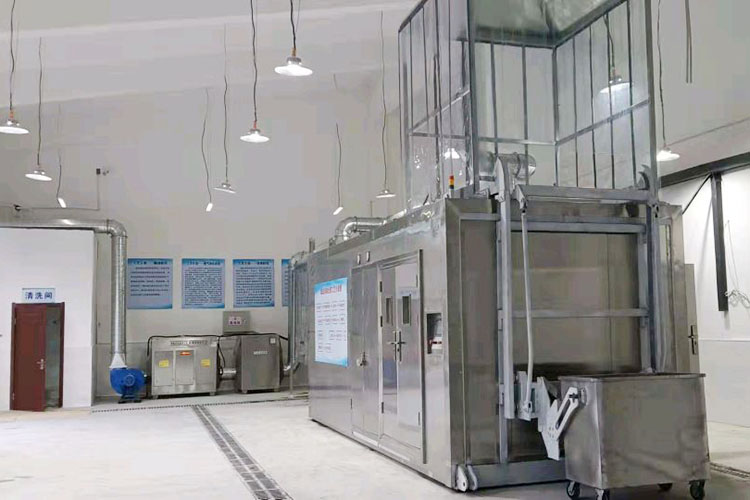As an important means of medical waste treatment, high-temperature cooking technology has become the first choice of many medical institutions and waste treatment units due to its efficient and stable sterilization ability, wide applicability and good environmental protection effect. Medical waste contains pathogens and other harmful substances. If not properly handled, it is very easy to pose a threat to the ecological environment and public health. With its mature and reliable operating procedures, high-temperature cooking technology can effectively inactivate pathogenic microorganisms in medical waste, thereby minimizing the potential risk of transmission. In the current field of medical waste treatment, despite the increasing number of technical means, high-temperature cooking still shows its irreplaceable advantages.

First of all, the core advantage of high-temperature cooking lies in its strong sterilization ability. Medical waste contains a large number of infectious bacteria, viruses and other pathogens, including high-risk microorganisms such as HIV, tuberculosis and hepatitis virus. If handled improperly, these microorganisms may be transmitted to the treatment personnel or leaked into the environment through air, contact and other channels, causing secondary pollution. High-temperature cooking disinfects and sterilizes medical waste under high temperature and high pressure conditions, generally requiring 15-30 minutes under conditions of above 121°C and 1.5 atmospheres of pressure. Such temperature and pressure conditions can quickly destroy the cell wall or nucleic acid structure of pathogens, ensuring that most pathogenic microorganisms lose their activity. In contrast, although other methods such as chemical disinfection also have a certain bactericidal effect, they are often not thorough enough in dealing with highly pathogenic pathogens. High-temperature cooking can be mainly physical sterilization, avoiding the residues that may be left by chemical disinfection, and is safer and more reliable.
Secondly, high-temperature cooking technology has a wide range of applicability. There are many types of medical waste, usually including waste of different materials such as discarded medical devices, reagent containers, syringes, disposable medical supplies, and bandages, gauze, needles, etc. used by patients. Since high-temperature cooking is a physical sterilization method, it is not sensitive to the form, material and type of waste, so it can adapt to various types of medical waste treatment needs. For example, some medical instruments with metal parts or structures will not corrode or burn due to chemical reactions during high-temperature cooking. Methods such as microwave treatment and chemical disinfection often have certain requirements on the form or material of waste and cannot fully handle complex types of medical waste. In addition, high-temperature cooking can also ensure the uniformity of disinfection when treating large-volume, sealed or unevenly water-containing wastes, and has strong adaptability, which makes it easy to apply in medical waste treatment needs of different scales and scenarios.

The environmental friendliness of high-temperature cooking technology is also worth mentioning. Since its core technology is to use high-temperature steam to harmlessly treat medical waste, no chemical agents are required in the whole process, so no chemical residues will be produced after disinfection and sterilization, and the burden of toxic and harmful substances will not be increased. In addition, if the wastewater and waste gas generated in the process of high-temperature cooking are properly treated, the emission standards can meet the requirements of environmental protection regulations and avoid pollution to the environment. In contrast, other treatment methods such as incineration will directly produce a large amount of smoke and harmful gases (such as dioxins), while chemical disinfection may leave chemical waste liquid after treatment, further increasing the difficulty of waste treatment. High-temperature cooking is cleaner, and the disinfected medical waste can be directly treated in the next step of solid waste, which greatly simplifies the entire process and meets the needs of modern environmental protection and safety.
In terms of operation and management, high-temperature cooking equipment has certain technical maturity and stability, and its management is relatively simple. The basic principle of high-temperature cooking equipment comes from the traditional high-pressure steam sterilizer. After years of technical improvement, the operation mode and safety performance of the equipment have become quite mature. The equipment maintenance is relatively simple, and there is no need to frequently replace core components or a lot of professional training. Therefore, in the management of high-temperature cooking equipment, each medical institution only needs to inspect and maintain it on schedule, which can reduce the training cost and management difficulty of personnel. In addition, due to the high degree of standardization of the equipment operation process, it is convenient to record and track the treatment status of each batch of medical waste, which helps to achieve standardized management.

In summary, high-temperature cooking technology has many significant advantages in the field of medical waste treatment. Its high efficiency sterilization ability, wide applicability, environmental protection, and convenient equipment management make it play an important role in the process of medical waste treatment. With the increase in the demand for medical waste treatment, high-temperature cooking technology can not only meet the strict sterilization requirements, but also show unique advantages in safety and environmental protection. In the future, with the further upgrading and optimization of equipment technology, the application prospects of high-temperature cooking in medical waste treatment will be broader.
Yongle Environmental Protection is mainly engaged in the research and development, production and sales of complete sets of technical equipment for organic solid waste disposal and comprehensive utilization. Production and manufacturing, domestic waste treatment equipment, tire pyrolysis equipment, medical waste disposal equipment, hazardous waste disposal equipment, and achieve efficient and comprehensive utilization of resources through independently developed low-temperature anaerobic pyrolysis equipment technology solutions.
Tags:Advantages of high temperature cooking equipment for medical waste,high temperature cooking equipment for medical waste,YONGLE GROUP
 Latest news
Latest news


























